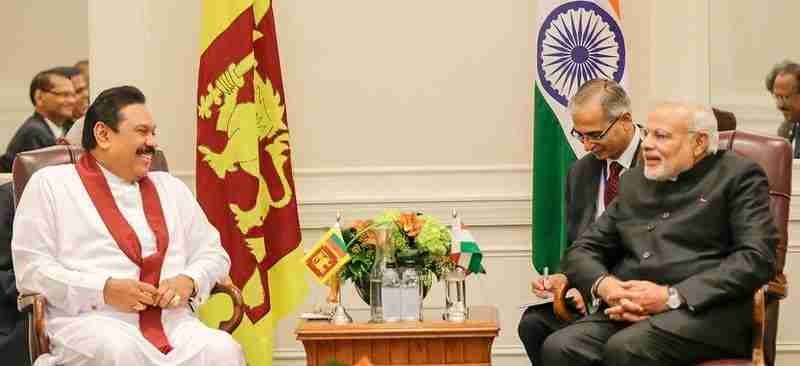Sri Lankan polity turned a full circle with the victory of Gotabaya Rajapaksa to the nation’s Presidency in November 2019. He became the first retired military officer to assume the top office and promptly named his elder brother, Mahinda, a two-term president himself, as prime minister. The Rajapaksa clan is now back at the helm of Sri Lankan polity
some five years after it was shown the door by the nation’s voters. Gotabaya of the Sri Lanka Podujana Peramuna (SLPP) won the presidency by 10.25 per cent margin of votes over his nearest rival Sajith Premadasa of the United National Party (UNP)-led coalition in last week’s elections. Though incumbent President Maithripala Sirisena and Prime Minister Ranil Wickremesinghe had come to power in 2014 with a promise to provide efficient governance, their internecine differences eventually led to a failed model of administration which was widely viewed as a big letdown after raising expectations. They failed Sri Lankans big time and the result was a longing for the Rajapaksa era.
These elections were framed by the wider security debate in Sri Lanka in the wake of a series of bombings on Easter Sunday earlier this year that killed more than 260 people and for which responsibility was claimed by the Islamic State of Iraq and the Levant (ISIL or ISIS). Gotabaya ran an effective campaign which underlined his credentials as the defence secretary who managed to bring to an end the bloody civil war between government forces and Tamil rebels. Majority of voters, largely Sinhalese, have once again reposed their faith in his ability to lead Sri Lanka at a time when they feel vulnerable.
But that’s also Gotabaya’s Achilles heel and his biggest challenge going forward. He has not received the support of the minorities and he will have to bridge this polarisation if he is to make his Presidency a success. Moreover, his global outreach will also remain a hostage to his past with him being a target of a campaign for alleged human rights abuses during the fight against the LTTE. The UN itself has blamed Sri Lankan security forces for killing more than 40,000 people during the last stages of the civil war. And that’s why for him, regional powers like China and India become all the more important.
New Delhi has been prompt in its outreach to the new President with External Affairs Minister S Jaishankar becoming the first foreign dignitary to call on Gotabaya last week with a letter of personal congratulations from Prime Minister Narendra Modi. India’s promptness in engaging with Gotabaya can be well understood in the context of concerns about the ‘pro-China’ tilt of the Rajapaksas. Despite India making its sensitivities clear to then defence secretary, Gotabaya had
pointedly allowed Chinese warships to dock at the Colombo harbour. This was followed by Mahinda Rajapaksa blaming Indian intelligence service for being the main force behind his 2014 election defeat.
Though the Sirisena government came to the office to rectify this supposed China-India imbalance in Sri Lankan foreign policy, it could do very little about the Chinese entanglement. It was under that dispensation, after all, that China managed to acquire Sri Lanka’s Hambantota port in 2017 as a debt swap. Chinese presence has only grown in the island nation over the last five years as Beijing has adopted a more assertive policy towards the Indian Ocean region. Earlier this year, Sri Lanka received a warship from China.
Sri Lanka is part of China’s Belt and Road Initiative as part of which it has received an estimated $8 billion as loans out of a total of around $11 billion Chinese investment in the country. China is heavily investing in major infrastructure projects including oil refineries, the Colombo International Financial Centre, a central highway connecting the capital Colombo with the central Kandy district and a $1.4 billion port city next to Colombo port.
Fears of a ‘debt trap’ are all-pervasive, however. It was the reason why Sri Lanka was forced to hand over control of Hambantota to China on a 99-year lease in 2017. Not surprising, therefore, that during his election campaign, Gotabaya promised to arbitrate anew, the leasing terms of the Hambantota port as well as underlying his desire to maintain strategic equidistance from Asian giants.
The debate in New Delhi about Gotabaya’s so-called ‘pro-China’ tilt is not only sterile but also futile. Gotabaya will be as much ‘pro-China’ as Sirisena turned out to be ‘pro-India.’ Nor should we expect that from the Sri Lankan leadership. In order to traverse the tricky terrain of regional power politics, smaller states will have to be pragmatic. Rather than being perpetually on the defensive about China’s growing footprint in India’s neighbourhood, India should play to its strengths.
New Delhi will always find it difficult to match the Chinese economic might. Instead, it should leverage it’s civilisational and cultural connect and ensure that its economic engagement produces concrete outcomes even as its red-lines are clearly communicated to the Sri Lankan leadership. If India has vital interests for which a partnership with Sri Lanka is critical, Sri Lanka too, cannot become a pivotal Indian Ocean power without a substantive engagement with India. That’s the reality that will continue to shape the reality of Indo-Sri Lankan ties irrespective of who is at the helm of their nation’s polities.


